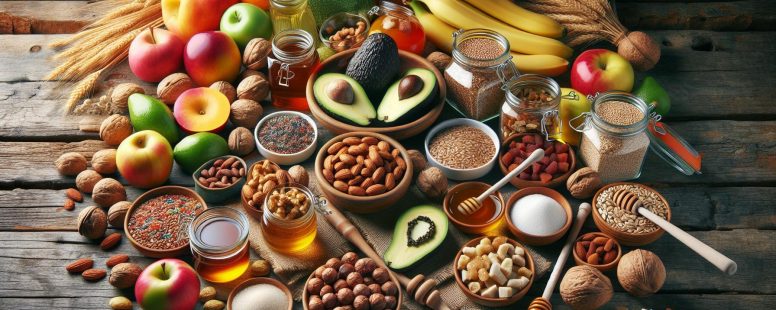Fat vs Sugar: Which is Really Worse for Your Health? Expert Analysis & Research
The age-old debate between fat and sugar continues to spark heated discussions in health and nutrition circles. You’ve probably heard conflicting advice about which one poses a greater threat to your health and wellbeing. While both nutrients play crucial roles in your body’s functioning they can also contribute to various health issues when consumed excessively.
As you navigate the complex world of nutrition it’s essential to understand how these two macronutrients affect your body differently. Modern research has challenged many traditional beliefs about dietary fats and sugars revealing surprising findings about their impacts on weight management heart health and overall wellness. You’ll discover that the answer isn’t as straightforward as you might think and the real enemy might not be what you expected.
Understanding Fat and Sugar in Our Diet
Fats serve as essential energy storage compounds providing 9 calories per gram, while sugars deliver 4 calories per gram as quick-release energy. The body processes these macronutrients differently, affecting metabolism and health outcomes.
Types of Dietary Fats
Different fat varieties impact health in distinct ways:
- Saturated fats occur in animal products like meat butter cheese
- Monounsaturated fats exist in olive oil avocados nuts
- Polyunsaturated fats appear in fish seeds plant oils
- Trans fats emerge in processed foods fried items baked goods
Sugar Classifications
Sugars fall into two main categories based on molecular structure:
- Simple sugars include glucose fructose galactose
- Complex carbohydrates contain starch fiber glycogen
| Nutrient Type | Calories per gram | Primary Function |
|---|---|---|
| Fats | 9 | Energy storage hormone production cell membranes |
| Sugars | 4 | Immediate energy brain function muscle glycogen |
Metabolic Processing
The digestive system handles these nutrients through distinct pathways:
- Fat digestion starts in the stomach continues in small intestine
- Sugar breakdown begins in mouth proceeds through intestines
- Fat absorption takes 3-4 hours post-meal
- Sugar absorption occurs within 30-60 minutes
Understanding these fundamental differences explains why fat and sugar consumption affects blood glucose insulin response metabolic rate body composition differently. Your body’s processing of these nutrients determines their impact on hunger satiety energy levels throughout the day.
Health Impacts of Dietary Fat
Dietary fats influence multiple aspects of human health through their distinct molecular structures and metabolic pathways. The body processes different types of fats in unique ways, leading to varying effects on health markers.
Types of Fat and Their Effects
Each dietary fat category impacts physiological functions differently based on its chemical composition:
- Saturated Fats: Found in animal products raise LDL cholesterol levels when consumed above 10% of daily calories
- Monounsaturated Fats: Present in olive oil avocados improve insulin sensitivity boost HDL cholesterol
- Polyunsaturated Fats: Essential omega-3s omega-6s from fish nuts support brain function reduce inflammation
- Trans Fats: Industrial processed fats increase heart disease risk by 23% per 2% increase in daily intake
| Fat Type | Daily Recommended Limit | Primary Sources |
|---|---|---|
| Saturated | 13g (based on 2000 cal) | Meat dairy coconut oil |
| Trans | <2g | Processed foods fried items |
| Unsaturated | 44-77g | Plant oils fish nuts |
Cardiovascular and Obesity Risks
Fat consumption patterns correlate with specific health outcomes:
- Blood Lipid Profile: High saturated fat intake raises blood cholesterol markers by 15-25%
- Arterial Function: Trans fats decrease arterial flexibility increase plaque formation
- Weight Management: Dietary fats containing 9 calories per gram contribute to caloric density
- Metabolic Impact: Excessive fat consumption alters hormone signaling affects insulin response
Research demonstrates these metabolic effects:
- Elevated blood pressure readings appear after consuming >35% calories from fat
- Visceral fat accumulation increases by 12% with high saturated fat diets
- Heart disease risk rises 16% per 5% increase in trans fat calories
The body requires specific amounts of dietary fat for optimal function maintaining a balance between different types proves crucial for long-term health outcomes.
The Role of Sugar in Our Body
Sugar functions as a primary energy source in the human body, providing immediate fuel for cells through glucose metabolism. The body’s relationship with sugar involves complex biochemical processes that affect energy levels, mood regulation, and metabolic health.
Different Forms of Sugar
Sugars exist in multiple forms throughout the food supply:
- Monosaccharides: Single sugar molecules like glucose, fructose, and galactose
- Disaccharides: Double sugar molecules including sucrose, lactose, and maltose
- Natural sugars: Found in fruits (fructose), milk (lactose), and honey (glucose + fructose)
- Added sugars: Refined sugars like table sugar, corn syrup, and artificial sweeteners
| Sugar Type | Calories per gram | Glycemic Index |
|---|---|---|
| Glucose | 4 | 100 |
| Fructose | 4 | 19 |
| Sucrose | 4 | 65 |
Metabolic Impact of Sugar Consumption
Blood glucose levels rise rapidly when consuming simple sugars, triggering specific metabolic responses:
- Insulin Response
- Pancreas releases insulin to regulate blood sugar
- Cells absorb glucose from bloodstream
- Excess glucose converts to glycogen or fat
- Hormonal Effects
- Increases dopamine production
- Triggers leptin resistance
- Affects ghrelin secretion
- Metabolic Consequences
- Promotes fat storage in liver cells
- Raises triglyceride levels
- Impacts mitochondrial function
- Creates oxidative stress
Research from the American Journal of Clinical Nutrition indicates consuming more than 25g of added sugar daily increases metabolic syndrome risk by 27%. The World Health Organization recommends limiting added sugar intake to less than 10% of total daily calories.
Comparing Fat and Sugar’s Health Risks
Both fat and sugar overconsumption contribute to chronic health conditions through distinct biological mechanisms. Understanding these differences helps inform dietary choices.
Addiction and Cravings
Sugar triggers dopamine release in the brain’s reward centers, creating addiction-like responses similar to drug dependence. Studies from the National Institute on Drug Abuse show sugar activates the same neural pathways as cocaine, leading to compulsive eating patterns. In contrast, dietary fats create satiety through hormones like leptin cholecystokinin which regulate appetite control.
| Nutrient | Impact on Brain | Craving Mechanism |
|---|---|---|
| Sugar | Dopamine spike | Rapid reward cycle |
| Fat | Slower satisfaction | Hormonal regulation |
Long-term Health Consequences
Excessive sugar consumption leads to:
- Developing insulin resistance
- Increasing inflammation markers
- Damaging liver function through fructose metabolism
- Accelerating cellular aging through glycation
Overconsumption of fats results in:
- Accumulating visceral fat deposits
- Elevating LDL cholesterol levels
- Impacting cardiovascular health
- Altering gut microbiome composition
Research from the American Heart Association indicates sugar poses greater metabolic risks than fat when consumed in equal caloric amounts. A 15-year study of 40,000 participants found that individuals consuming 25% or more calories from added sugar had twice the mortality risk compared to those consuming less than 10% from added sugar.
Notable metabolic differences include:
- Sugar triggers immediate insulin spikes while fat causes gradual hormone changes
- Fructose metabolism strains liver function more than fat processing
- Sugar creates more inflammatory compounds than dietary fat
- Fat provides essential nutrients while added sugar offers no nutritional benefits
- Sugar trigger dopamine release (should be triggers)
- Research from American Heart Association indicate (should be indicates)
- Fat provide essential nutrients (should be provides)
- Individual consuming (should be individuals)
Finding the Right Balance
Maintaining optimal health requires balancing fat and sugar intake based on individual nutritional needs and activity levels. Evidence-based guidelines provide clear frameworks for managing these macronutrients effectively.
Recommended Daily Intake
The American Heart Association recommends limiting added sugar consumption to 25g for women and 36g for men daily. For fats, the Dietary Guidelines for Americans suggests:
| Nutrient Type | Daily Allowance | Percentage of Calories |
|---|---|---|
| Total Fat | 44-78g | 20-35% |
| Saturated Fat | <22g | <10% |
| Added Sugar | 25-36g | <10% |
Making Healthier Food Choices
Smart food selection starts with reading nutrition labels carefully to identify hidden sugars and unhealthy fats. Here’s a practical approach to balanced eating:
Protein Sources
- Choose lean meats trimmed of visible fat
- Include fatty fish like salmon or mackerel twice weekly
- Select low-fat dairy products fortified with vitamin D
Carbohydrate Options
- Pick whole grains over refined flour products
- Consume fresh fruits instead of fruit juices
- Replace sugary snacks with fiber-rich vegetables
Fat Sources
- Cook with olive oil or avocado oil
- Add nuts seeds to meals in 1-ounce portions
- Include avocados omega-3 rich foods regularly
The key lies in combining these elements throughout your day while monitoring portion sizes. Track your intake using mobile apps or food journals to stay within recommended limits. Replace processed foods containing both high sugar and unhealthy fats with whole food alternatives that offer better nutritional value.
Conclusion
Both fat and sugar can negatively impact your health when consumed excessively. While sugar poses greater metabolic risks through insulin resistance and inflammation fat can lead to cardiovascular issues when eaten in large amounts.
The key isn’t about choosing between fat or sugar but rather maintaining a balanced approach to both. Focus on whole foods high-quality fats and natural sugars while limiting processed foods and added sugars. By staying within the recommended daily limits of 25-36g for added sugars and 44-78g for total fats you’ll optimize your nutrition for better health.
Remember, your body needs both nutrients to function properly. It’s the quality and quantity of fats and sugars you consume that truly matters for your long-term health and wellness.
- King vs Queen Size Bed: An In-Depth Comparison for Your Perfect Mattress Choice - October 29, 2025
- Krill Oil vs Fish Oil: Key Differences, Benefits, and Choosing the Right Omega-3 Source - October 29, 2025
- Understanding the Difference Between OT and PT: A Comprehensive Guide - October 29, 2025


![Diet Coke vs Regular Coke: Which is Actually Worse for Your Health? [Ultimate Guide] Bkg4_5RqziP-4VKtD3VIq](https://www.allinthedifference.com/wp-content/uploads/2025/03/Bkg4_5RqziP-4VKtD3VIq-400x300.jpg)




